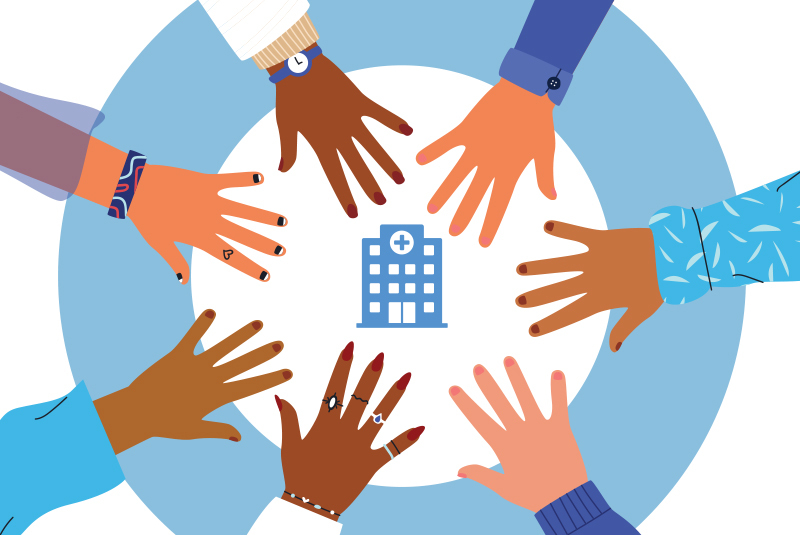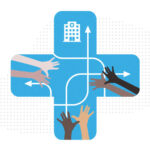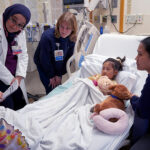Standing up to microaggressions: A hospital-wide training

How can a large, teaching hospital address racial bias in the midst of a pandemic? This question came to a head last summer as the country reacted to the death of George Floyd.
As a champion for children’s health, and as part of its Declaration on Equity, Diversity, and Inclusivity, Boston Children’s Hospital committed to being a more inclusive working and learning environment. With such a large and diverse organization, and given the centuries-long history of structural racism in this country, putting these goals into action would require participation across every sector of the hospital.
Tackling microaggressions through education
The Bystander-to-Upstander Inclusive Workplace Training grew out of a workshop originally intended for a much smaller group. “We were working with the Office of Health Equity and Inclusion to plan a training on microaggressions for medical fellows and physicians,” says Sonia Ballal, MD, of the Division of Gastroenterology, Hepatology and Nutrition. Then the group received a request from hospital leaders to expand the training to include all of Boston Children’s 12,000+ employees, and the scope of their plans changed dramatically.
Why microaggressions?
Microaggressions, often in the form of stereotypical jokes or comments, discriminate against people from marginalized groups in subtle ways. Targets are left feeling dismissed or singled out for their race, ethnicity, gender or gender identity, sexual orientation, disability, or religion (to name a few). “Microaggressions can impact the way patients perceive health care,” says Geeranan Chuersanga, program coordinator in the Office of Health Equity and Inclusion. “When they come from a provider, microaggressions can undermine patient trust.”
Examples of microaggressions
- complimenting a Black person for being “articulate”
- assuming someone with a Latino name doesn’t speak English
- expecting an Asian American person to be good at science
- saying “I’m not going to bother” rather than learn how to pronounce a person’s name
By their very nature, microaggressions make it difficult to speak up without being seen as overly sensitive or making trouble. In most cases, the person making the comment doesn’t realize they’ve said or done anything hurtful. Yet the comment or action affects anyone who sees or overhears them. “Almost anyone you talk with can recall instances of witnessing a microaggression,” says Ballal. “The experience of being a bystander and not speaking up tends to linger as guilt or helplessness.”
The team set out to provide tools that would enable people to be upstanders rather than bystanders.
Planning a workshop around active, customized learning
“We have subject matter expertise,” says Valerie L. Ward, MD, MPH, Boston Children’s chief equity and inclusion officer. “But when we were asked to develop a training for all of Boston Children’s clinicians, researchers, and staff, we knew we needed programmatic expertise as well.”
Ward and her colleagues collaborated with Boston Children’s chief education officer, Alan M. Leichtner, MD, MSHPEd. At his suggestion, they designed a training around the principles of adult learning. “To be effective, the training needed to engage individuals in a way that’s relevant to them,” says Leichtner. To this end, they included ample time for participants to practice responding to microaggressions in smaller breakout groups.
To make the training relevant and facilitate practice, the team customized microaggression scenarios for several different settings: clinical, research, and administrative. Each situation grew out of personal experience. “The scenarios are real, not made up. Many of them are based on things members of the training committee have witnessed or experienced ourselves,” says Chuersanga.
The ACT framework for intervention
- Ask for permission to respond.
- Communicate disagreement or displeasure by deflecting the action.
- Tell the person why the comment was hurtful or problematic.
Bystander-to Upstander training workshops are 90 minutes long. Participants are first introduced to microaggressions and the “ACT framework” for intervening. They then move into breakout groups of eight to 10 people. Each person reads a microaggression scenario out loud and practices responding using the ACT framework. The full group then reconvenes for a final review of the material.
Since the training was first rolled out in February 2021, several departments have requested scenarios specific to their work environments. The team has been happy to oblige. “We can customize scenarios for any group,” says Judy Zola, director of Learning and Development. “Learning is much more valuable when participants can relate to the situations discussed.”
Aiming for 100% participation
Boston Children’s has committed to having every member of its workforce participate in a Bystander-to-Upstander workshop. The pandemic, and the fact that online meetings have become a fact of everyday life, have helped: More than 3,700 employees participated in the training between February and July 2021. “We can train up to 250 people at a time on the Zoom platform,” says Ward. Even in such large groups, the breakout room function facilitates small group discussions.
“I can’t imagine how we could have reserved enough time in conference rooms to train so many people in such a short period of time,” says Leichtner. Still, the team knows online training won’t work for staff who don’t have easy access to a computer. For this reason, they plan to offer in-person trainings later this year.
Feedback and future plans
Participants have expressed widely different reactions to the training in post-workshop surveys. Many have said they feel their experience has been recognized for the first time. Others have a hard time believing microaggressions take place at Boston Children’s. “To have such opposite reactions, often within the same group — it’s a reminder of how many perspectives there are at Boston Children’s,” says Ballal.
Many participants have requested more opportunities to talk about microaggressions and practice responding. While the education team remains focused on training the hospital’s remaining 8,000 employees, they are also developing a facilitation guide for department managers. “Many managers don’t know where to begin when it comes to discussions of race,” acknowledges Zola. “The guide will provide advice and support so they can lead these difficult but important discussions.”
Bystander to Upstander Training Committee
Committee members come from a variety backgrounds and bring a broad range of expertise to the development and rollout of the training. Core members include:
Valerie L. Ward, MD, MPH, Chief Equity and Inclusion Officer, Pediatric Radiologist, Department of Radiology
Alan M. Leichtner, MD, MSHPEd, Chief Education Officer and Chair, Department of Education, Physician, Division of Gastroenterology, Hepatology and Nutrition
Sonia A. Ballal, MD, Staff Physician, Division of Gastroenterology, Hepatology and Nutrition
Stephen Brown, MD, Pediatric Radiologist, Department of Radiology
Geeranan Chuersanga, MS, Program Coordinator, Office of Health Equity and Inclusion
Eva Gómez, MSN RN NPD-BC CPN, Senior Professional Development Specialist, Clinical Education, Informatics, Practice & Quality
Donna Luff, PhD, Director of Curriculum Design and Quality, Simulator Program
Lori Newman, MEd, Director of Professional Development in Education, Department of Education
Dennis Spencer, MD, PhD, Staff Physician, Division of Gastroenterology, Hepatology and Nutrition
Nikki Tennermann, LICSW, Former Administrative Director, Office of Health Equity and Inclusion
Judy Zola, MBA, Director of Learning and Development
Learn more about Boston Children’s Office of Health Equity and Inclusion.
Related Posts :
-

Making pediatric health equity research truly equitable: An EDI review process
A burgeoning number of studies are examining pediatric health equity, diversity, and inclusion (EDI). But if not done right, health ...
-

Medical care for youth with neurodevelopmental disabilities: A call for change
According to national data, one in six children has a neurodevelopmental disability (NDD) such as autism, intellectual disability, or ADHD. ...
-

Revisiting race and ethnicity in clinical guidelines
Health care institutions often rely on clinical pathways in assessing patients and making decisions about their care. Some of these ...
-

Helping clinicians embrace family-centered rounds
If you’ve ever been hospitalized, you may have experienced this: groups of doctors coming in and talking about you ...





